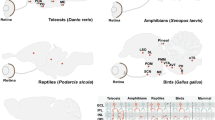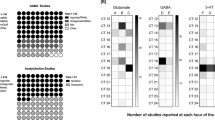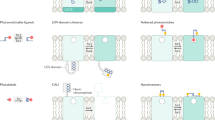Abstract
Melanopsin, expressed in a subset of retinal ganglion cells, mediates behavioral adaptation to ambient light and other non-image-forming photic responses. This has raised the possibility that pharmacological manipulation of melanopsin can modulate several central nervous system responses, including photophobia, sleep, circadian rhythms and neuroendocrine function. Here we describe the identification of a potent synthetic melanopsin antagonist with in vivo activity. New sulfonamide compounds inhibiting melanopsin (opsinamides) compete with retinal binding to melanopsin and inhibit its function without affecting rod- and cone-mediated responses. In vivo administration of opsinamides to mice specifically and reversibly modified melanopsin-dependent light responses, including the pupillary light reflex and light aversion. The discovery of opsinamides raises the prospect of therapeutic control of the melanopsin phototransduction system to regulate light-dependent behavior and remediate pathological conditions.
This is a preview of subscription content, access via your institution
Access options
Subscribe to this journal
Receive 12 print issues and online access
$259.00 per year
only $21.58 per issue
Buy this article
- Purchase on Springer Link
- Instant access to full article PDF
Prices may be subject to local taxes which are calculated during checkout




Similar content being viewed by others
References
Hatori, M. & Panda, S. The emerging roles of melanopsin in behavioral adaptation to light. Trends Mol. Med. 16, 435–436 (2010).
Pryse-Phillips, W.E. et al. Guidelines for the diagnosis and management of migraine in clinical practice. Canadian Headache Society. CMAJ 156, 1273–1287 (1997).
Good, P.A., Taylor, R.H. & Mortimer, M.J. The use of tinted glasses in childhood migraine. Headache 31, 533–536 (1991).
Do, M.T. & Yau, K.W. Intrinsically photosensitive retinal ganglion cells. Physiol. Rev. 90, 1547–1581 (2010).
Panda, S. et al. Illumination of the melanopsin signaling pathway. Science 307, 600–604 (2005).
Walker, M.T., Brown, R.L., Cronin, T.W. & Robinson, P.R. Photochemistry of retinal chromophore in mouse melanopsin. Proc. Natl. Acad. Sci. USA 105, 8861–8865 (2008).
Choe, H.W. et al. Crystal structure of metarhodopsin II. Nature 471, 651–655 (2011).
Okada, T. et al. The retinal conformation and its environment in rhodopsin in light of a new 2.2 Å crystal structure. J. Mol. Biol. 342, 571–583 (2004).
Pulivarthy, S.R. et al. Reciprocity between phase shifts and amplitude changes in the mammalian circadian clock. Proc. Natl. Acad. Sci. USA 104, 20356–20361 (2007).
Kefalov, V.J., Crouch, R.K. & Cornwall, M.C. Role of noncovalent binding of 11-cis-retinal to opsin in dark adaptation of rod and cone photoreceptors. Neuron 29, 749–755 (2001).
Melyan, Z., Tarttelin, E.E., Bellingham, J., Lucas, R.J. & Hankins, M.W. Addition of human melanopsin renders mammalian cells photoresponsive. Nature 433, 741–745 (2005).
Qiu, X. et al. Induction of photosensitivity by heterologous expression of melanopsin. Nature 433, 745–749 (2005).
Wong, K.Y., Dunn, F.A. & Berson, D.M. Photoreceptor adaptation in intrinsically photosensitive retinal ganglion cells. Neuron 48, 1001–1010 (2005).
Hartwick, A.T. et al. Light-evoked calcium responses of isolated melanopsin-expressing retinal ganglion cells. J. Neurosci. 27, 13468–13480 (2007).
Fu, Y. et al. Intrinsically photosensitive retinal ganglion cells detect light with a vitamin A–based photopigment, melanopsin. Proc. Natl. Acad. Sci. USA 102, 10339–10344 (2005).
Do, M.T. et al. Photon capture and signalling by melanopsin retinal ganglion cells. Nature 457, 281–287 (2009).
Panda, S. et al. Melanopsin is required for non-image-forming photic responses in blind mice. Science 301, 525–527 (2003).
Berson, D.M. Phototransduction in ganglion-cell photoreceptors. Pflugers Arch. 454, 849–855 (2007).
Lucas, R.J., Douglas, R.H. & Foster, R.G. Characterization of an ocular photopigment capable of driving pupillary constriction in mice. Nat. Neurosci. 4, 621–626 (2001).
Lucas, R.J. et al. Diminished pupillary light reflex at high irradiances in melanopsin-knockout mice. Science 299, 245–247 (2003).
Lall, G.S. et al. Distinct contributions of rod, cone, and melanopsin photoreceptors to encoding irradiance. Neuron 66, 417–428 (2010).
Noseda, R. et al. A neural mechanism for exacerbation of headache by light. Nat. Neurosci. 13, 239–245 (2010).
Johnson, J. et al. Melanopsin-dependent light avoidance in neonatal mice. Proc. Natl. Acad. Sci. USA 107, 17374–17378 (2010).
Provencio, I., Jiang, G., De Grip, W.J., Hayes, W.P. & Rollag, M.D. Melanopsin: An opsin in melanophores, brain, and eye. Proc. Natl. Acad. Sci. USA 95, 340–345 (1998).
Nayak, S.K., Jegla, T. & Panda, S. Role of a novel photopigment, melanopsin, in behavioral adaptation to light. Cell. Mol. Life Sci. 64, 144–154 (2007).
Isoldi, M.C., Rollag, M.D., Castrucci, A.M. & Provencio, I. Rhabdomeric phototransduction initiated by the vertebrate photopigment melanopsin. Proc. Natl. Acad. Sci. USA 102, 1217–1221 (2005).
Palczewski, K. et al. Crystal structure of rhodopsin: a G protein–coupled receptor. Science 289, 739–745 (2000).
Standfuss, J. et al. The structural basis of agonist-induced activation in constitutively active rhodopsin. Nature 471, 656–660 (2011).
Jastrzebska, B., Orban, T., Golczak, M., Engel, A. & Palczewski, K. Asymmetry of the rhodopsin dimer in complex with transducin. FASEB J. 27, 1572–1584 (2013).
Craig, D.A. The Cheng-Prusoff relationship: something lost in the translation. Trends Pharmacol. Sci. 14, 89–91 (1993).
Kenakin, T.P. A Pharmacology Primer: Theory, Application and Methods (Elsevier Academic Press, London, 2006).
Hatori, M. et al. Inducible ablation of melanopsin-expressing retinal ganglion cells reveals their central role in non-image forming visual responses. PLoS ONE 3, e2451 (2008); erratum http://dx.doi.org/10.1371/annotation/c02106ba-b00b-4416-9834-cf0f3ba49a37 (2008).
Brown, T.M. et al. Melanopsin contributions to irradiance coding in the thalamo-cortical visual system. PLoS Biol. 8, e1000558 (2010).
Acknowledgements
We thank N. Boyle, B. Li, A. Pieris, R. Li, P. Rao, M. Cajina, H. Zhang (Lundbeck), H. Le, S. Keding (Salk Institute) for expert technical help. This work was supported by grants from the Hearst Foundation; US National Institutes of Health (NIH) grants NIH EY 016807, S10 RR027450 and NS066457 to S.P.; a Japan Society for the Promotion of Science fellowship to M.H.; Fyssen and Catharina foundation fellowships to L.S.M.; and NIH grant NIH EY017809 to P.J.S. and G.E.P.
Author information
Authors and Affiliations
Contributions
K.A.J., M.H., L.S.M., J.R.B., R.A., S.-P.H., M.M., H.Z., Q.Z. and A.T.E.H. did the experiments. K.A.J., M.H., L.S.M., J.R.B., A.T.E.H., P.J.S., G.E.P., S.P. and J.S. analyzed the results and prepared figures. K.A.J., J.S., A.T.E.H., P.J.S., G.E.P. and S.P. designed experiments and prepared the manuscript.
Corresponding authors
Ethics declarations
Competing interests
K.J., R.A., S.-P.H., M.M., H.Z. and J.S. performed experimental work while they were employees of Lundbeck Research USA.
Supplementary information
Supplementary Text and Figures
Supplementary Results, Supplementary Figures 1–10 and Supplementary Tables 1–4 (PDF 1588 kb)
Supplementary Movie 1
Negative phototaxis of wild-type neonatal (P8) mouse treated with vehicle. The first 2 min of the movie shows the pup's activity inside a plexiglass tube under complete darkness. The next 2 min shows the response to bright blue light illuminated from the left (shown as an arrow) of the plexiglass tube. The movie is sped up 4×. (MOV 19088 kb)
Supplementary Movie 2
Evaluation of negative phototaxis in a wild-type neonatal (P8) mouse treated with AA92593.The first 2 min of the movie shows the pup's activity inside a plexiglass tube under complete darkness. The next 2 min shows the response to bright blue light illuminated from the left (shown as an arrow) end of the plexiglass tube. The movie is sped up 4X. (MOV 20445 kb)
Supplementary Movie 3
Evaluation of negative phototaxis in neonatal (P8) Opn4–/– mouse. The first 2 min of the movie shows the pup's activity inside a plexiglass tube under complete darkness. The next 2 min shows the response to bright blue light illuminated from the left (shown as an arrow) end of the plexiglass tube. The movie is sped up 4×. (MOV 27461 kb)
Rights and permissions
About this article
Cite this article
Jones, K., Hatori, M., Mure, L. et al. Small-molecule antagonists of melanopsin-mediated phototransduction. Nat Chem Biol 9, 630–635 (2013). https://doi.org/10.1038/nchembio.1333
Received:
Accepted:
Published:
Issue Date:
DOI: https://doi.org/10.1038/nchembio.1333
This article is cited by
-
Assessing migraine patients with multifocal pupillographic objective perimetry
BMC Neurology (2021)
-
Advances toward precision medicine for bipolar disorder: mechanisms & molecules
Molecular Psychiatry (2021)
-
Diversity of intrinsically photosensitive retinal ganglion cells: circuits and functions
Cellular and Molecular Life Sciences (2021)
-
Pharmacological Manipulation of the Circadian Clock: A Possible Approach to the Management of Bipolar Disorder
CNS Drugs (2019)
-
Subcutaneous white adipocytes express a light sensitive signaling pathway mediated via a melanopsin/TRPC channel axis
Scientific Reports (2017)



